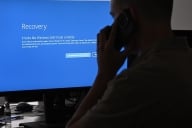You have /5 articles left.
Sign up for a free account or log in.
What do we mean when we talk about the “edtech community”?
Who are the people that we are talking about? Where do they work? What are the jobs that they do?
One way to think about the edtech community is to use the U.S. intelligence community (IC) as a reference group.
According to the Washington Post website on the The Black Budget, the intelligence community consists of:
- 107,035 Total Employees
- 83,675 Civilian Employees
- 23,400 Military Contractors
- 21,800 Full-Time Contractors
Of these, the CIA employs 21,459 civilians. The NSA has 14,950 military people.
Total spending on the intelligence budget - spending that covers covert action, surveillance, and counterintelligence - is $52.6 billion. Two-thirds of spending goes to the CIA ($14.7 billion), the NSA ($10.8 billion), and the National Reconnaissance Office (NRO - $10.3 billion).
Can we put some similar numbers to the edtech community?
One place to start is the Bureau of Labor Statistics (BLS) Occupational Outlook Handbook. The closest category that I can find is Instructional Coordinators. This occupational category might not be a great fit, however, as it includes people who work in secondary education as well as postsecondary.
According to the BLS, there are 151,000 people working as Instructional Coordinators. Between 2014 and 2024, this sector is expected to add 10,500 jobs - a 7% growth rate. The median pay is $61,550, and the typical entry-level education is a Master’s degree.
Another place to look is on job search sites. Type “technology” into https://careers.insidehighered.com and you come up with 4,089 open jobs. A search for “instructional technology” yields 2082 jobs, and “instructional designer” get you 1667 positions.
LinkedIn has 4,180 Instructional Design jobs in higher education open in the U.S. Indeed.com has 22,288 jobs under “higher education technology”.
None of these methods, however, seem to give us a good picture of the scope or location of the postsecondary edtech community.
The part of the edtech community that I know best are the learning people. The folks working directly with faculty and students on online, blended, and residential instruction. The instructional designers, project managers, and media educators. When I think of edtech it is mostly these learning folks that I am thinking about.
The other side of the edtech house is administrative (or enterprise) technology professionals. These are the people who run our enterprise financial and student systems, our networks, our databases, our servers, our storage, and our mission critical institutional applications.
The campus edtech community also includes everyone working in information security, research computing, desktop IT support, and a million other roles (from programmers to web developers and everything in-between).
Any list of who is included in the higher ed edtech community runs the risk of excluding key players. Where does the increasingly important role of Centers for Teaching and Learning (CTL’s) play in the edtech community? What about the academic library?
So far, I have only touched on the institutional (colleges and universities) part of edtech community. The edtech community also includes the people and companies that make up a growing and vibrant educational technology ecosystem.
How many companies can you name off the top of your head in the edtech space? Would you start with the edtech pure plays? Or would you talk about the traditional educational publish companies that are reinventing themselves as digital learning companies? Maybe you’d talk about edtech startups? Or big tech companies with large educational technology businesses?
How can we get a handle on the edtech community?
How should we define who’s in, and who’s out, of the edtech community?
Once we get some definitions, how can we count (and map) this edtech community?
Does thinking about the intelligence community help us think about the postsecondary edtech community?








